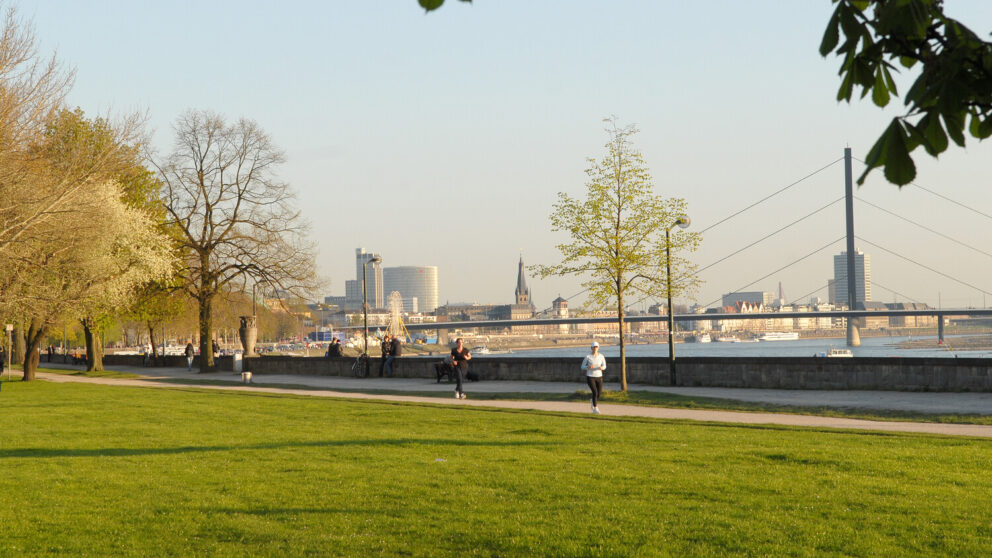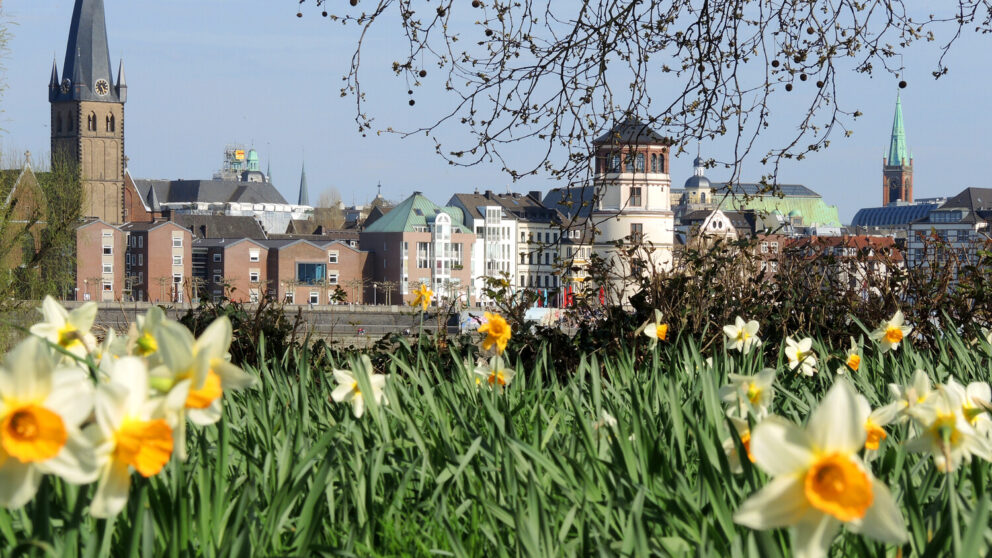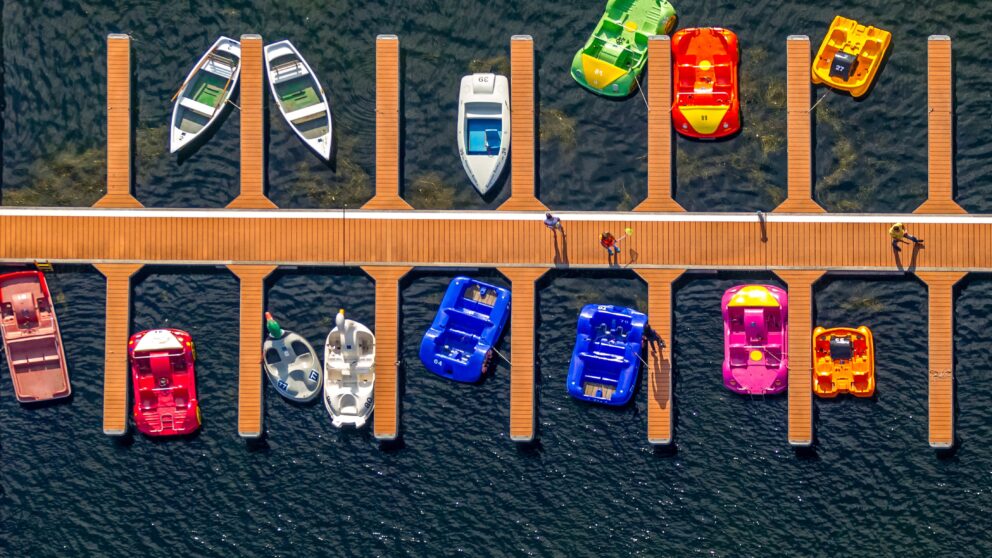
Six walks that will bring you closer to spring
Six walks that will bring you closer to spring
Out into the air
Finally done. The days are getting longer, the trees and meadows are green again. Is there nothing keeping you indoors now? And would you like to combine a spirited ride with a beautiful experience of nature and a visit to Düsseldorf's sights? Then we have something for you. On the following six routes you can meet the approaching spring. Whether alone, as a couple, with family, friends or colleagues, you will experience the most diverse facets of the Rhine metropolis. It has been proven that tours on foot are not only ideal for contemplation or profound conversations, but also open up completely new perspectives.
For botanists: The South Park
Is the annual spring awakening still a great miracle for you? Because you enjoy every new blossom, every fresh green? Then you should direct your steps to the Südpark these days. With a total area of 70 hectares, it is Düsseldorf's largest park and is crisscrossed with countless winding paths. Therefore, we do not recommend a single route, but rather you should go on an exploration tour yourself, let yourself drift from one flowering bush to the next, following the example of the butterflies. A good starting point for this walk is the Zeitfeld, an installation of tall station clocks by artist Klaus Rinke, directly opposite the Volksgarten S-Bahn station. From there, we head directly south, first through the so-called Volksgarten, the oldest part of the park, which was laid out in 1895/96. Some of the giant trees that stand here by romantic ponds with beautifully curved shorelines would probably have a lot to tell. Adjacent to the Volksgarten is the former Buga area, which was laid out for the Federal Garden Show in 1987 and surprises with its incredible variety of plants. In the areas "Vor dem Deich" (In front of the dike) and "In den Gärten" (In the gardens), water basins overgrown with water lilies and pretty benches invite visitors to take a short break. Those who are good on foot and have more than an hour to spare should also visit the Botanical Garden, which beckons with its futuristic-looking greenhouse in the far south of the grounds, near the university.
For urban explorers: The Millionaire's Hill at the North Cemetery
The last shirt has no pockets. And yet wealth during one's lifetime sometimes makes all the difference after death. That is, if you have found your final resting place on a slight elevation of Düsseldorf's North Cemetery. The place is popularly known as "Millionaire's Hill. This is because the burial grounds on this hill are primarily occupied by industrialists and bankers. So if you are interested in Düsseldorf's city history, a tour of the 70-hectare North Cemetery, which was laid out in 1884, is definitely worthwhile. Especially since it doesn't look morbid at spring awakening, but has become a popular oasis of peace among the living thanks to the park-like character created by Eduard Hoppe at the time. Whether you enter the cemetery park from Ulmenstraße or from the side of Danziger Straße, you must not miss fields 61 and 64. The path between these gravesites is like a walk through German industrial history. Düsseldorf was considered the "desk of the Ruhr" and many of the names found on Millionaires' Hill have inscribed themselves in the city's historical memory. The most significant grave, not least because of its imposing layout, is probably that of the Henkel family on field 75, where company founder Fritz Henkel also found his final peace. Other illustrious names: Franz Haniel, who played an important role in the steel industry, August Bagel, founder of a printing and publishing house, banker Gottfried Trinkaus or Veba boss Rudolf-Christian von Bennigsen-Foerder. The name Detlev Rohwedder recalls a dark chapter in history. The head of the Treuhandanstalt was murdered by RAF terrorists in Düsseldorf in 1991.
For water sports fans: Little Hawaii
The Rhine, the great water artery that cuts through Düsseldorf, offers countless opportunities for walks. In particular, the left bank of the Rhine, with its extensive meadows, old poplars, grazing flocks of sheep and beautiful sandy beaches, invites you to take an extended tour. Depending on your physical condition and the time available, you can walk for miles upstream or downstream. Particularly pretty, however, is the section of the route that belongs to the Lörick district. The start is the Theodor Heuss Bridge. From here, the route heads north toward Lörick's open-air swimming pool, either directly along the water or along the dike. The idyllic Rhine beaches, shaded by willows and located in the immediate vicinity of the "Löricker", have been christened 'Little Hawaii' by the vernacular. In several fine sandy bays, which are lined up like pearls on a string, you can spread out your picnic blanket and watch the hustle and bustle on the river. Barges lying deep in the water, sailing their cargo toward Rotterdam, small pleasure boats, rowers, and jet skis gone wild share the wide stream. When it's time to head back, take a short detour to the marina, stop for a sundowner at Rheinclub 297 before heading back south above the Lörick open-air swimming pool.
For friends of flora and fauna: The Rotthäuser Bachtal
The special features of this valley, located about 20 minutes by car west of downtown on the Bergische Landstrasse, are its wetlands, its springs, the numerous fish ponds and extensiven Reed beds. Plants like the giant horsetail or the watercress are at home here. On a walk along the brook and through the alder, ash, beech and softwood floodplain forests you can meet the pond warbler, the reed bunting and the kingfisher. The blue-green mosaic dragonfly, which belongs to the group of dragonflies, will also be happy to accompany you part of the way through its habitat. Possible starting point is the equestrian farm Gut Moschenhof. Keep going in the direction of the Gerresheim cemetery and then walk down to the left across a meadow and a sunken path into the brook valley. Arrived at the marshy ponds in the hollow you have the choice. There are several possibilities to walk through the woods on the other side of the valley. The landmark here is the Papendelle estate with its large goose pond, from which you can walk past cow pastures back in the direction of the cemetery. The last part of the path leads steeply up the forest. When you reach the cemetery, you can already see the paved road that will take you back to the starting point of the hike, the Moschenhof estate. These seven kilometers have not yet satisfied your wanderlust? No problem! The designated nature reserve of the Rotthäuser Bachtal is extensive.
For architecture fans: The Media Harbor
Architecture is written with a capital A in Düsseldorf. Because some big names have already set up a monument in the metropolis on the Rhine. In addition to the Kö-Bogen I (Daniel Libeskind) and II (Christoph Ingenhoven), located at the northern end of the boulevard and on the neighboring Gustaf-Gründgens-Platz, you can also take a look at other architectural superlatives, especially in the Media Harbor. Why not combine marveling at the creativity of the great master builders with a nice afternoon stroll through the former industrial area? The tour starts at the streetcar stop "Speditionsstraße", directly in front of the headquarters of Trivago - one of the world's largest hotel search engines, which had a white building with a curved facade of glass and concrete designed here by the architectural group SOP. It provides space for a good 2,000 employees. On the planted roof there is a running track, and in the courtyard there are restaurants and a moat. Directly opposite is the "Float," the new administrative building by star architect Renzo Piano. The buildings, which are connected to each other by a transition, look like ice floes that have been broken open at random, and their axes correspond with the streets that surround the spacious grounds. At the same time, the building seems to float above everything due to its freestanding first floor. At the end of Speditionsstraße, the massive structure of the Hyatt Regency design hotel rises up. It was designed by the architectural group SOP/JSK. The architectural ensemble also includes the pedestrian bridge that now leads you to the next landmark: the triad "Neuer Zollhof 1-3" by architect Frank Gehry. There is no straight line here. 1531 window boxes protrude from the three buildings with their different facades. Neuer Zollhof 1 is made of brick. House number 3 is plastered white, while the lower Zollhof 2 has a stainless steel facade. The sister buildings to the right and left are reflected in it. Masterful! The icing on the cake is then the Rhine Tower at the tip of the harbor, which at 240 meters high is the tallest building in Düsseldorf. Fancy a rest? At the top of the tower is the Japanese restaurant Qomo, which rotates once around its own axis in 72 minutes. And from the viewing platform below, you can retrace your tour from a bird's eye view.
For romantics: The Benrath Palace Park
It is pure splendor. The baroque, pink candy-colored Benrath Palace alone, which Düsseldorfers lovingly refer to as their little Versailles, is a feast for the eyes. And the palace park is in no way inferior to the building. There is no better place for a romantic stroll for two than the listed park in the south of Düsseldorf. It was designed by palace architect Nicolas de Pigage, who had a geometric system of paths and squares carved into the dense forest of the former zoo between 1755 and 1770: a gem of horticulture! On the one hand, there are the private gardens of the builder Karl Theodor and his wife Elisabeth Auguste, an English-style walk garden on the western side of the palace and a Baroque garden drawn with a compass and ruler on the eastern side. You should definitely pay a visit to the large kitchen garden and the orangery, which houses the Museum of European Garden Art. In total, the green lung covers more than 61 hectares, of which around 45 hectares are designated as a nature reserve. And rightly so: the park is home to more than 80 species of birds and over 300 species of beetles. So you stroll through the park like royalty, stopping at this or that secluded bench and trying to spot and name the birds chirping in the treetops above you. Finally, a piece of cake in the castle café - you really can't welcome spring in a more fitting manner.
Title image: Düsseldorf Tourism




